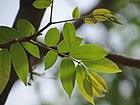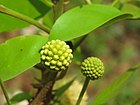Note: This is a project under development. The articles on this wiki are just being initiated and broadly incomplete. You can Help creating new pages.
Xylia xylocarpa
Xylia xylocarpa is a deciduous tree with a dense crown usually growing 20 - 40 metres tall, though on dry and poor sites the tree may be smaller and the bole crooked. The bole is usually straight and cylindrical, sometimes with small buttresses. It can be unbranched for 12 metres or more and around 40 - 60cm in diameter.
Contents
- 1 Uses
- 2 Parts Used
- 3 Chemical Composition
- 4 Common names
- 5 Properties
- 6 Habit
- 7 Identification
- 8 List of Ayurvedic medicine in which the herb is used
- 9 Where to get the saplings
- 10 Mode of Propagation
- 11 How to plant/cultivate
- 12 Commonly seen growing in areas
- 13 Photo Gallery
- 14 References
- 15 External Links
Uses
Worms, Leprosy, Vomiting, Diarrhoea, Gonorrhoea, Ulcers, Rheumatism, Piles, Leprosy.[1]
Parts Used
Chemical Composition
It contains The mature seeds contained 29.5% crude protein, 14.78% crude fat, 8.02% crude fibre, 5.11% ash and 42.6% crude carbohydrates. The seeds appeared to be a good source of potassium, magnesium, phosphorus and iron.[2]
Common names
| Language | Common name |
|---|---|
| Kannada | ಬೆಟ್ಟದಾವರಿಕೆ ಮರ Bettadavarike mara, ಹೊನ್ನಾವರಿಕೆ Honnavarike |
| Hindi | Jambu, Jambu |
| Malayalam | Irula, Katamaram |
| Tamil | Iruvel |
| Telugu | Boja, Errachennangi |
| Marathi | Jambha, Suriya |
| Gujarathi | |
| Punjabi | |
| Kashmiri | |
| Sanskrit | Kanakakuli, Shinshapa |
| English | Burma Ironwood, Pyinkado |
.[3]
Properties
Reference: Dravya - Substance, Rasa - Taste, Guna - Qualities, Veerya - Potency, Vipaka - Post-digesion effect, Karma - Pharmacological activity, Prabhava - Therepeutics.
Dravya
Rasa
Guna
Veerya
Vipaka
Karma
Prabhava
Habit
Identification
Leaf
| Kind | Shape | Feature |
|---|---|---|
Flower
| Type | Size | Color and composition | Stamen | More information |
|---|---|---|---|---|
| {{{5}}} |
Fruit
| Type | Size | Mass | Appearance | Seeds | More information |
|---|---|---|---|---|---|
Other features
List of Ayurvedic medicine in which the herb is used
Where to get the saplings
Mode of Propagation
How to plant/cultivate
A plant of the moist to wet lowland tropics, occasionally to elevations of 850 metres.[5]
Commonly seen growing in areas
Dry evergreen forest, Mixed deciduous forest, Dry deciduous dipterocarp forest, Higher altitude forests.
Photo Gallery
References
- ↑ Indian Medicinal Plants by C.P.Khare
- ↑ Chemical constituents
- ↑ Common names
- ↑ [Morphology]
- ↑ Cultivation
External Links
- Pages using duplicate arguments in template calls
- Ayurvedic Herbs known to be helpful to treat Worms
- Ayurvedic Herbs known to be helpful to treat Leprosy
- Ayurvedic Herbs known to be helpful to treat Vomiting
- Ayurvedic Herbs known to be helpful to treat Diarrhoea
- Ayurvedic Herbs known to be helpful to treat Gonorrhoea
- Ayurvedic Herbs known to be helpful to treat Ulcers
- Ayurvedic Herbs known to be helpful to treat Rheumatism
- Ayurvedic Herbs known to be helpful to treat Piles
- Herbs with Fruits used in medicine
- Herbs with Seeds used in medicine
- Herbs with common name in Kannada
- Herbs with common name in Hindi
- Herbs with common name in Malayalam
- Herbs with common name in Tamil
- Herbs with common name in Telugu
- Herbs with common name in Marathi
- Herbs with common name in Sanskrit
- Herbs with common name in English
- Habit - Tree
- Index of Plants which can be propagated by Seeds
- Herbs that are commonly seen in the region of Dry evergreen forest
- Herbs that are commonly seen in the region of Mixed deciduous forest
- Herbs that are commonly seen in the region of Dry deciduous dipterocarp forest
- Herbs that are commonly seen in the region of Higher altitude forests
- Herbs









